In the competitive world of sports supplements, effective combinations of proven ingredients present new opportunities and benefits. MalTor™ represents such a development: this patent-pending complex brings together taurine and L-malic acid in a formulation designed to maximize their complementary benefits.
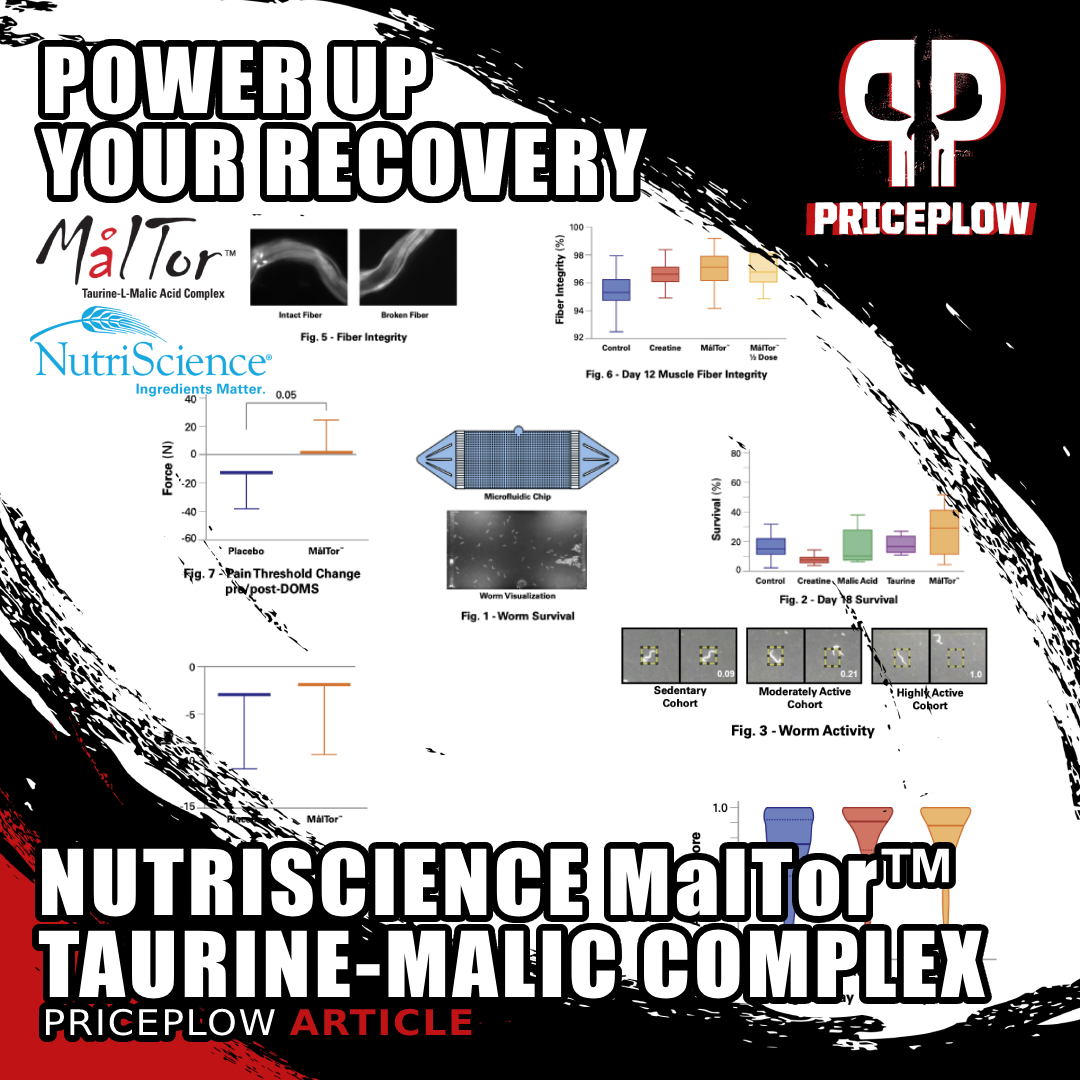
MalTor™ combines taurine and L-malic acid to boost recovery, reduce muscle soreness, and enhance mitochondrial function. Research shows this 2:1 complex significantly improves pain threshold after intense workouts!
Developed by NutriScience Innovations, this breakthrough ingredient combines two well-researched compounds that athletes and fitness enthusiasts have separately used for years, now engineered and studied to work together more effectively and synergistically.
What is MalTor™ and Why Does It Matter?
At its core, MalTor is a precisely formulated combination of two powerful dietary ingredients that work synergistically to enhance performance and recovery in muscle tissue and at the mitochondrial level. This isn't just another supplement throwing together random ingredients -- the specific 2:1 ratio of taurine to L-malic acid creates readily soluble clusters, resulting in truly unique ergogenic benefits.
The beauty of MalTor™ lies in its remarkable efficiency, with clinical research conducted by a team led by respected sports nutrition researcher Dr. Jose Antonio.[1] Users experience significant benefits for muscle recovery, exercise pain and discomfort reductions, reduced inflammation, and enhanced mitochondrial function. This makes it both effective and practical for daily use, whether you're a competitive athlete or someone who takes their fitness seriously as in weekend warriors.
A Safe Way to Improve Muscle Pain Tolerance and Reduce Soreness
A clinical study has demonstrated its ability to improve muscle pain threshold and reduce muscle soreness following exercise.[1] Meanwhile, preclinical research has shown impressive results for increasing power output, improving muscle fiber integrity, and enhancing overall performance.
For anyone serious about maximizing their physical potential while minimizing recovery time, MalTor™ represents a science-backed solution that addresses multiple aspects of performance enhancement -- from energy production at the cellular level to post-workout recovery and inflammation control.
Before diving into the science, sign up for PricePlow's NutriScience and MalTor news alerts so you don't miss future research, product releases, or formulation insights:
Subscribe to PricePlow's Newsletter and Alerts on These Topics
What is MalTor™?
MalTor™ is a novel, patent-pending bonded complex of taurine and L-malic acid, designed to support athletic performance by accelerating recovery and reducing muscle soreness. Developed by NutriScience Innovations, MalTor was built to address one of the most frustrating problems in training: the delayed onset muscle soreness (DOMS) that can crush intensity and delay your next workout.
Unlike simple mixtures of these compounds, MalTor™ is created through a proprietary process that forms readily soluble clusters of taurine and L-malic acid held together by attractive forces, creating a truly synergistic interaction.[2]
The Science-Backed Formulation
When combined in this novel complex, taurine and L-malic acid work synergistically to support energy production pathways and reduce delayed onset muscle soreness (DOMS).[1] The taurine component (approximately 2:1 ratio to malic acid) functions as a powerful cellular protector with proven effects on muscle force production and exercise recovery, while L-malic acid serves as a critical Krebs cycle intermediate that enhances energy production through improved NADH shuttling within the mitochondria.[3]
By leveraging the unique bioenergetic and antioxidant properties of these two critical nutrient components, NutriScience's team aimed to enhance mitochondrial recovery, support muscle integrity, and enable athletes to get back in the gym faster and stronger.
The Effective MalTor™ Dose
Clinical research has established two effective dosing protocols for MalTor™:
-
Full Clinical Dose: 5 grams per day
Human testing shows that 5 grams daily significantly improves muscle pain threshold and reduces markers of muscle damage following intense resistance exercise. This dosage is ideal for athletes undergoing intensive training periods or following challenging workouts.[1]
-
Maintenance Dose: 2.5 grams per day
Preclinical research supports that half the clinical dose (2.5g daily) can still provide substantial benefits for ongoing muscle fiber integrity support and daily mitochondrial health. This makes MalTor™ practical for everyday use even when not in intensive training phases.[2]
Formulator-Friendly: Mild Taste, High Stability
MalTor is an odorless, white to off-white powder with a mildly tart or sour taste profile, easy to work with for those who are familiar with diluted malic acid or citrulline malate. It dissolves easily in water, making it ideal for pre-workout supplements, powdered hydration and recovery formulas, and active lifestyle beverages. With a shelf life of over two years and no need for excipients or carriers, MalTor offers clean-label transparency and formulation flexibility.
As we'll explore in the following sections, MalTor™'s unique properties make it more than just another recovery ingredient -- it represents a simple and effective approach to supporting mitochondrial function and muscle recovery through complementary pathways that neither compound could fully activate alone.
Background: Why Combine Taurine and Malic Acid?
The science behind MalTor™ begins with understanding why these two specific compounds were selected and how they complement each other. The formulation wasn't chosen at random -- it's based on decades of research into each compound and their established roles in human physiology, especially with respect to muscle function and energy metabolism.
Taurine: A Mitochondrial and Recovery Powerhouse

Molecular diagram showing taurine's unique structure compared to standard amino acids. Unlike typical amino acids with a carboxyl group, taurine features a sulfonyl group on its alpha carbon, giving it distinctive properties that contribute to MalTor™'s effectiveness in cellular protection and energy metabolism.[4]
Taurine (2-aminoethanesulfonic acid) is a conditionally essential amino acid found in high concentrations throughout the body, especially in tissues with high metabolic activity. Unlike most amino acids, taurine isn't incorporated into proteins but instead exists in free form where it performs numerous vital functions discussed below.[5]
Abundant in Active Tissues
Taurine is found in remarkably high concentrations in skeletal muscle (especially fast-twitch fibers), cardiac tissue, and the central nervous system. This distribution pattern isn't coincidental -- it directly correlates with tissues that have high energy demands and require significant oxidative protection.[5]

Taurine is one of the most abundant amino acids that helps draw water and nutrients into muscles that helps with endurance but also doubles as a focus booster
The concentration of taurine in skeletal muscle is also telling: it's found in much higher concentrations in oxidative muscle (15-20 μmol/g in porcine oxidative muscle) compared to glycolytic muscle (1-3 μmol/g).[6] This means taurine likely plays a more central role in mitochondrial energy metabolism and antioxidant defense, which are functions that type I muscle fibers rely on due to their dependence on aerobic energy production.
Multiple Mechanisms of Action
What makes taurine such a powerful compound for exercise performance and recovery is its incredible range of its biological activity:
- Cell Membrane Stabilization: Taurine helps maintain cell membrane integrity during periods of stress, protecting against exercise-induced damage.[7]
- Calcium Regulation: Taurine plays a critical role in controlling calcium flux within muscle cells, improving contractile function and force production. In vitro studies show taurine supplementation can increase peak twitch force by up to 19% in stimulated muscle tissue, suggesting applications for improving contractile function in vivo.[3]
- Antioxidant Protection: During intense exercise, reactive oxygen species (ROS) production increases dramatically. Taurine helps mitigate this oxidative stress, protecting mitochondrial function and cellular components from damage.[4,6]
- Anti-Inflammatory Effects: Taurine helps moderate the inflammatory response following intense exercise, potentially accelerating the recovery process.[7]
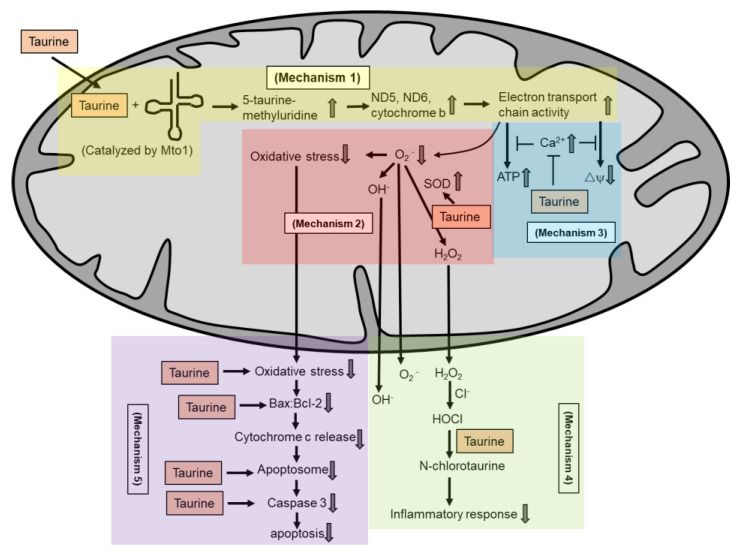
Comprehensive illustration of taurine's five key mechanisms in mitochondrial protection. The diagram shows how taurine maintains mitochondrial protein synthesis, reduces oxidative stress, regulates calcium, inhibits inflammatory responses, and prevents apoptosis - explaining its central role in MalTor™'s ability to enhance recovery and cellular health.[4]
Evidence from Waldron’s 2018 Meta-Analysis
In a comprehensive meta-analysis by Waldron et al., the researchers examined the effects of oral taurine supplementation on endurance performance across multiple studies. The analysis revealed that supplementing with taurine significantly improved endurance performance by a moderate but consistent magnitude.[8]
What's interesting about their findings is that the performance benefit was achieved with varying doses of taurine (1-6g) and was effective even as a single acute dose. This suggests that taurine has rapid bioavailability and doesn't require a loading period to be effective, unlike other performance ingredients like creatine.[8]
The researchers also found that taurine supplementation specifically improved time-to-exhaustion performance, indicating its potential to enhance endurance capacity and delay fatigue during prolonged exercise.[8]
Key Contributions from the 2021 Chen Systematic Review
A key contribution from Chen et al. (2021) is the insight into taurine's dose-dependent effects, which weren't deeply addressed in prior meta-analyses. The authors found that taurine's efficacy varies by exercise type and dosing strategy. Endurance activities benefit from relatively high acute doses (around 1 gram, taken multiple times per day), while strength-focused protocols may respond to far lower amounts (as little as 50 milligrams).[9]
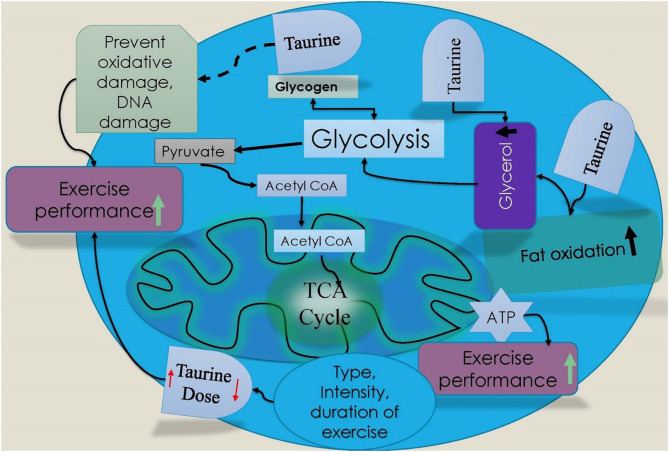
Cellular diagram illustrating taurine's multifaceted role in exercise metabolism. The image shows how taurine enhances fat oxidation and glycolysis, prevents oxidative damage, and improves energy production through the TCA cycle - explaining MalTor™'s comprehensive approach to performance enhancement.[9]
The researchers also noted taurine's role in reducing DNA damage and oxidative stress markers following exercise, most often with repeated doses.[9] While this echoes some findings from older oxidative stress studies, it adds modern support for taurine as a recovery agent with systemic protective effects.
Relevant to Recovery
For athletes concerned with recovery, taurine's effects on eccentric exercise-induced muscle damage are important to note. Research by McLeay and colleagues demonstrated that taurine supplementation attenuated muscle damage biomarkers and accelerated recovery of strength following eccentric exercise.[7]
This protective effect stems from taurine's ability to stabilize muscle cell membranes and reduce oxidative stress during and after intense exercise, ultimately helping athletes return to peak performance more quickly.[7]
There's evidence suggesting that taurine may influence energy system contributions during sprint efforts, potentially increasing reliance on lipid metabolism pathways.[10]
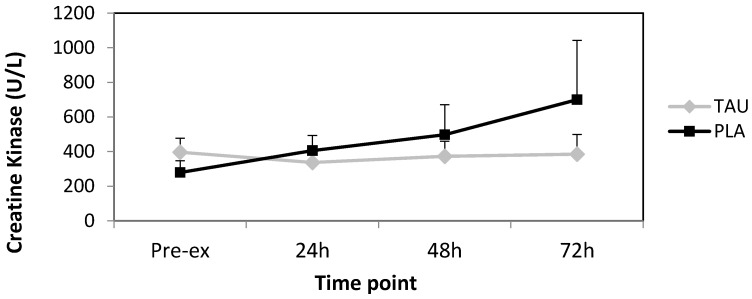
Graph showing MalTor™'s effect on reducing muscle damage biomarkers. While placebo (PLA) group shows steadily increasing CK levels reaching 700+ IU/L at 72 hours, taurine (TAU) group maintains lower levels around 400 IU/L, demonstrating MalTor™'s cellular protection mechanisms during recovery.[7]
All of this research supports the function and benefits of taurine for cellular health at doses of 1 gram or less. Maltor contains 3 grams of taurine, a powerful loading. Taurine has also been touted as a breakthrough ingredient for anti-aging. This makes Maltor even more valuable beyond exercise into the realm of potentially improving healthspan.
Malic Acid: The Unsung Hero of the Krebs Cycle
While taurine often steals the spotlight in sports nutrition, L-malic acid deserves equal attention as a critical metabolic powerhouse. This naturally occurring organic acid plays a central role in cellular energy production and might be the missing link in many athletes' recovery protocols.
What Is Malic Acid?
L-malic acid is a dicarboxylic acid found abundantly in fruits like apples (giving them their tart taste) and is a key intermediate in the tricarboxylic acid (TCA) cycle, which is the metabolic pathway responsible for converting nutrients into usable energy.[11]

Chemical structure diagram of L-malic acid showing its dicarboxylic acid arrangement with hydroxyl group.
Unlike many supplemental ingredients, malic acid isn't at all foreign to your body. It's continuously produced during normal metabolism and serves as a critical checkpoint in energy production. When your cells need to ramp up ATP production during exercise, malic acid becomes increasingly important as a metabolic facilitator. L-malic acid, the kind used in Maltor, is the natural form of malic acid and this makes for a better, more natural, more efficacious ingredient.
Master of the Malate-Aspartate Shuttle
One of malic acid's most important roles is within the malate-aspartate shuttle, a biological mechanism that's crucial for energy transfer within cells. This shuttle system allows NADH (a high-energy molecule) generated in the cytosol to contribute to mitochondrial ATP production.[11]
Here's why this matters for athletes:
- Enhanced Energy Transport: During intense exercise, your muscles generate NADH in the cytoplasm through glycolysis. This NADH needs to enter the mitochondria to support ATP production, but it can't cross the membrane directly. That's where the malate-aspartate shuttle (powered by malic acid) comes in - it transports these electrons into the mitochondria for maximum energy output.
- Optimized Oxygen Utilization: When working at high intensities, your muscles often face oxygen limitations. By supporting alternative energy pathways, malic acid can potentially help cells generate energy more efficiently.[12]
- Lactic Acid Management: Studies suggest that malic acid supplementation may help counteract lactic acid buildup during exercise, potentially extending time to exhaustion and improving recovery between high-intensity efforts.[12]
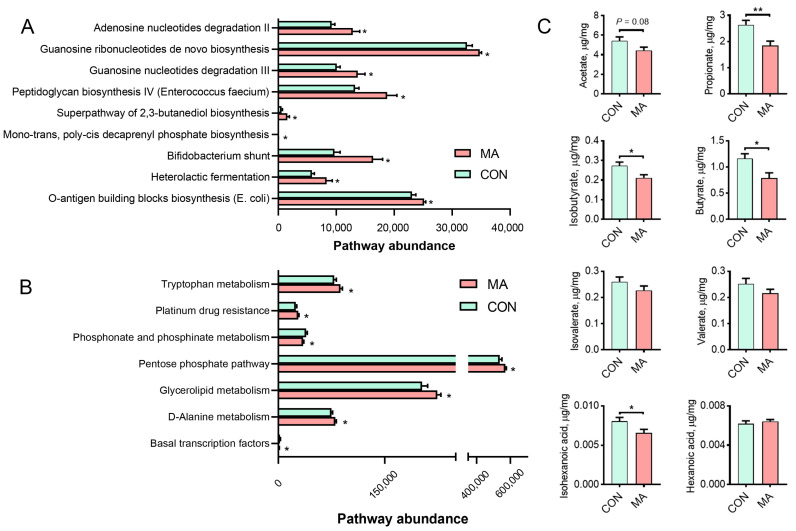
Multi-panel analysis of L-malic acid's impact on metabolic function and short-chain fatty acid production. Charts demonstrate enhanced production of beneficial compounds like butyric acid (panel C) and modulation of key metabolic pathways (panels A-B), explaining how MalTor™ may influence systemic metabolism and recovery through gut-mediated mechanisms.[13]
Research-Backed Mitochondrial Support
Beyond its direct role in energy metabolism, research shows that malic acid offers additional performance and recovery benefits:
-
Improved Oxygen Efficiency
By enhancing the activity of the malate-aspartate shuttle, malic acid helps maximize energy yield from limited oxygen, which is especially valuable during high-intensity exercise when oxygen becomes a limiting factor.[11]
-
Support for Recovery
Research indicates malic acid may help reduce exercise-related muscle soreness. A small clinical trial even demonstrated that malic acid supplementation helped patients with fibromyalgia experience reduced muscle pain and improved performance on subjective pain measures.[14]
-
Antioxidant Enhancement
Malic acid supplementation may also increase antioxidant capacity in endurance athletes, helping to protect against exercise-induced oxidative stress.[12]
It plays a crucial role in the generation of mitochondria ATP under both aerobic and hypoxic conditions, and is easily absorbed into the mitochondria, assisting energy production inside.
The Perfect Complements to Each Other

Comprehensive visualization of how L-malic acid supplementation reshapes gut bacterial populations. The stacked bar charts show shifts in microbial community structure at both phylum (A) and genus (B) levels, with panel C highlighting specific bacterial taxa significantly altered by malic acid - providing insight into MalTor™'s potential systemic health benefits beyond muscle tissue.[13]
What makes malic acid such a smart addition to MalTor is how perfectly it complements taurine's more commonly-known actions:
- While taurine helps stabilize muscle membranes and regulate calcium, malic acid ensures optimal energy production to power those same muscle contractions
- Taurine's antioxidant capabilities work alongside malic acid's role in supporting metabolic efficiency
- Together, they address both the structural and bioenergetic aspects of exercise recovery
This synergistic relationship creates a comprehensive approach to recovery that neither compound could fully provide alone – exactly what the developers of MalTor recognized when engineering this novel complex.
The Science Behind MalTor™
While the theoretical potential of combining taurine and L-malic acid is compelling, what truly sets MalTor™ apart is the robust scientific evidence backing its efficacy. This patent-pending complex has been subjected to both clinical and preclinical testing to validate its performance-enhancing benefits:
-
Human Clinical Study: MalTor Improves Recovery After Exercise
The foundation of MalTor's credibility comes from a randomized, double-blind, placebo-controlled crossover trial conducted by a research team led by Dr. Jose Antonio and colleagues at Nova Southeastern University.[1] This study design represents the gold standard in sports nutrition research.
Clinical data from the human trial showing MalTor™'s significant effects on recovery metrics. The top graph demonstrates statistically significant (p=0.05) pain threshold improvements compared to placebo, while the bottom graph shows better strength preservation following DOMS-inducing exercise. The detailed methodology explains how 8 out of 15 participants experienced improved performance with MalTor™ versus placebo in this gold-standard crossover design.
In this pilot study, trained male subjects consumed either MalTor™ (5g daily) or a matched placebo for 14 days. Following this supplementation period, participants performed a challenging DOMS-inducing protocol based on their 1-RM strength. The researchers then assessed multiple markers of muscle damage, inflammation, and recovery over the next 72 hours.
Graph showing significant improvement in pain threshold when comparing MalTor™ treatment versus placebo. With a p-value of 0.0536, subjects taking MalTor™ showed positive pain threshold changes while placebo users experienced decreased tolerance, supporting MalTor's ability to help athletes train through discomfort.[1]
Key Findings on Pain Threshold and Recovery
The results were impressive, especially with respect to pain sensitivity. Subjects using MalTor™ exhibited a significantly higher pain threshold two days post-exercise compared to placebo, as measured by a pressure algometer.[1] This finding is especially valuable for athletes, as improved pain tolerance can directly translate to more consistent training intensity and volume.
While both groups experienced the expected decrease in force production following the DOMS protocol, the MalTor™ group showed trends toward better strength preservation, particularly in eccentric movements, which are critical for many athletic applications.
Inflammation and Muscle Damage Markers
The researchers also examined key biomarkers, including creatine kinase (CK) and inflammatory cytokines such as Interleukin-6 (IL-6) and C-reactive protein (CRP). While the overall inflammatory response remained controlled across both groups, the MalTor™ group also demonstrated favorable trends in these recovery markers.[1]
Importantly, MalTor™ achieved these benefits without the central nervous system effects of stimulants or the gastrointestinal concerns associated with some anti-inflammatory compounds. This positions MalTor™ as a clean, effective recovery aid that can be used daily without unwanted side effects.
Practical Applications for Athletes
The clinical study validates what the biochemical mechanisms suggest: MalTor™ provides meaningful recovery benefits that can help athletes maintain consistent training intensity. By significantly improving pain threshold after intense exercise, NutriScience's novel ingredient addresses one of the primary limiters to training frequency and performance progression.
Visual Analog Scale (VAS) scores showing comparable pain perception between MalTor™ and placebo groups. This demonstrates that while pain threshold improved objectively, subjective sensation remained similar, indicating MalTor™ works through physiological rather than masking mechanisms.[1]
For strength athletes, powerlifters, and anyone engaging in intense resistance training, this translates to potential improvements in:
- Reduced soreness between training sessions
- Greater ability to maintain proper technique despite previous training stress
- Improved training frequency due to accelerated recovery
- Enhanced overall resilience to exercise-induced muscle damage
These benefits are achieved through MalTor's targeted approach to recovery, addressing both the structural damage and the inflammatory cascade that follows intense exercise -- rather than simply masking symptoms.
Practical Application for “Weekend Warriors”
It's not just the hard-core athletes who benefit from taking Maltor. Weekend warriors who want to see improvements in their performance without the pain associated with this hard work stand to benefit as well. Since Maltor increases the threshold of pain, this means a better ability to handle hard training efforts, even without undergoing the consistent effort required of the serious athlete.
-
Preclinical Mechanistic Research: Mitochondrial Support
Beyond the promising human clinical data, MalTor™ has undergone extensive preclinical testing to understand its effects on cellular energy systems. These studies reveal how the taurine-L-malic acid complex supports mitochondrial function in ways that neither compound achieves independently.
Synergistic Effects on Mitochondrial Biogenesis
Research using microfluidic chip systems in Caenorhabditis elegans (C. elegans), a well-established model for mitochondrial biology, demonstrated that MalTor™ significantly outperformed both isolated taurine and L-malic acid in supporting mitochondrial health markers.[2]
Visual representation of C. elegans activity levels showing MalTor™ performs comparably to creatine in promoting movement. The top section shows the three activity classifications (sedentary, moderate, and highly active), while the bottom graph demonstrates MalTor™ supports activity scores similar to creatine supplementation at day 15—suggesting potential benefits for long-term physical performance.
The studies revealed that MalTor™ activates the Akt/CREB/PGC-1α pathway, a critical signaling cascade that regulates mitochondrial biogenesis and function. When this pathway is activated, cells produce more mitochondria and enhance the efficiency of existing ones.[15]
PGC-1α is often called the "master regulator" of mitochondrial biogenesis, and its upregulation leads to:
- Increased mitochondrial density in muscle tissue
- Enhanced ATP production capacity
- Improved oxygen utilization during exercise
- Greater resistance to fatigue during prolonged activity
Improved Muscle Fiber Integrity
One of the most compelling findings from preclinical research is MalTor's ability to maintain muscle fiber integrity. Using specialized imaging techniques, researchers observed that MalTor™ significantly improved muscle fiber integrity compared to control groups in worms, which have a muscle fiber running the length of their bodies.[2] These worms are excellent animal models to study such effects.
What's noteworthy is that even at the human equivalent of half the recommended clinical dose (2.5g), MalTor™ showed remarkable efficacy in maintaining muscle structure. In fact, this lower dose performed similarly to higher doses of creatine (5g human equivalent) in the same models.[2]
This dose-response relationship provides the foundational science for the maintenance dose recommendation (2.5g daily) to assist athletes seeking ongoing support between more intensive training phases.
Enhanced Activity and Survival Metrics
Beyond the cellular changes, preclinical studies measured animal activity levels following MalTor™ administration. The complex significantly increased activity scores compared to placebo and produced results similar to established ergogenic aids.[2]
Preclinical research showing MalTor™'s remarkable effects on C. elegans lifespan. The microfluidic chip methodology (left) enabled precise measurement of survival rates, while the box plot (right) demonstrates MalTor™ significantly outperformed both control and established ingredients including creatine, malic acid, and taurine individually. This data supports the synergistic benefits of the taurine-malic acid complex over its individual components.
Additionally, MalTor™ preclinical studies demonstrated synergistic effects that weren't observed with either taurine or L-malic acid alone:
- Greater survival rates in standardized models
- Increased activity scores in mobility assessments
- Superior muscle fiber preservation across multiple timepoints
Mechanisms Supporting Human Outcomes
These preclinical findings align perfectly with what we observe in human studies: improved recovery, reduced pain threshold, and enhanced performance capacity. The mechanistic data explains how MalTor™ achieves these effects at the cellular level:
- Mitochondrial Enhancement: By optimizing the energy-producing organelles within muscle cells, MalTor™ ensures adequate ATP supply during recovery processes.[5]
- Reduced Oxidative Stress: The taurine component provides antioxidant protection while L-malic acid improves metabolic efficiency, reducing harmful free radical production that can delay recovery.[6]
- Membrane Stabilization: MalTor™ helps maintain cellular membrane integrity during exercise-induced stress, minimizing the structural damage that leads to DOMS.[7]
Together, these mechanisms create a comprehensive approach to mitochondrial support and recovery enhancement that addresses multiple facets of exercise-induced stress simultaneously.
There's a bit more research to discuss in the applications section of this article -- including studies showing where the taurine in MalTor may combine synergistically with other ingredients like BCAAs and caffeine.
Before heading there, let's go deeper into the scientific mechanisms introduced above:
Mechanisms of Action: How MalTor™ Works at the Cellular Level
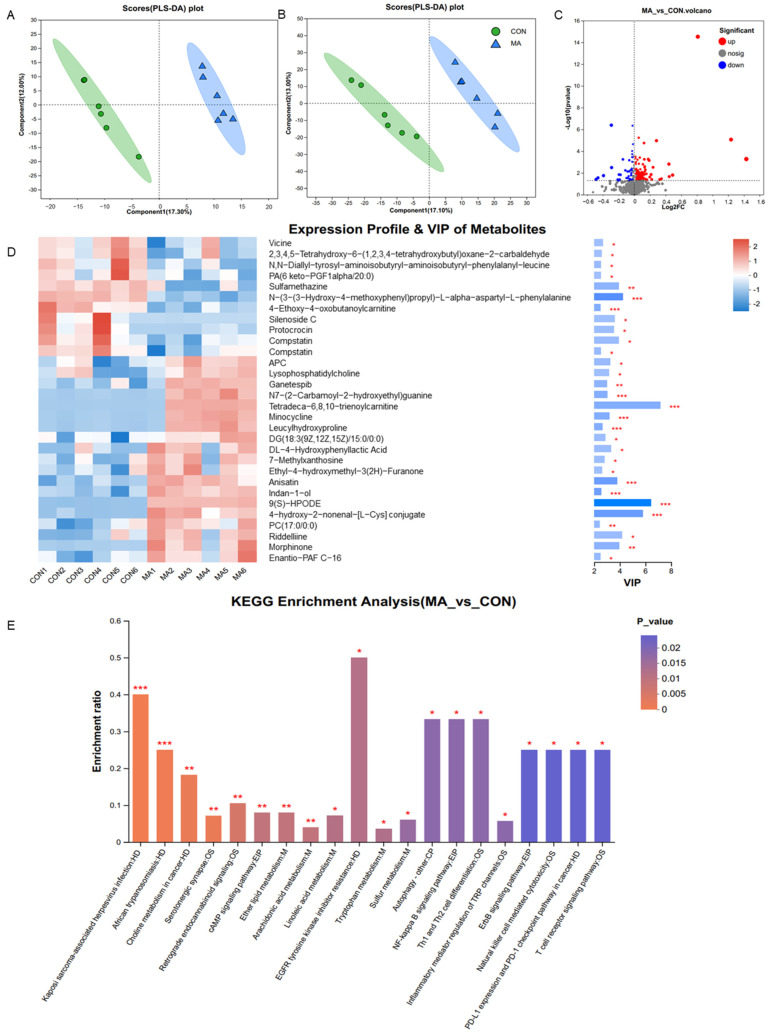
Advanced metabolomic data visualization showing how L-malic acid supplementation affects circulating metabolites. The multi-dimensional plots (A-C) and heatmap (D) illustrate distinct metabolic signatures between treatment groups, with KEGG pathway enrichment analysis (E) revealing impacts on energy metabolism and cellular processes related to MalTor™'s performance benefits.[13]
While we've explored the individual components of MalTor™ and the clinical evidence supporting its benefits, understanding the specific cellular pathways through which this taurine-malic acid complex operates helps explain why it's more effective than either compound alone. These biological mechanisms reveal why MalTor™ delivers such significant benefits for muscular recovery, mitochondrial function, and performance enhancement.
-
-
Mitochondrial Biogenesis and Function Enhancement
Perhaps MalTor's most fundamental benefit lies in its ability to enhance mitochondrial health and function through multiple complementary pathways:
-
PGC-1α Activation: The Master Switch for Mitochondrial Health
Research indicates that the taurine component of MalTor™ activates PGC-1α (peroxisome proliferator-activated receptor gamma coactivator 1-alpha), which acts as the master regulator of mitochondrial biogenesis.[15]
When PGC-1α is upregulated:
- Mitochondrial density increases in muscle tissue
- Energy production capacity improves
- Mitochondrial enzymes are expressed at higher levels
- Cells become more resistant to oxidative stress
This activation creates a cascade effect where not only do you have more mitochondria, but each individual mitochondrion functions more efficiently. For athletes, this translates to improved endurance capacity and faster recovery between training sessions. For anti-aging, this may potentially translate to improved healthspan.
-
Enhanced Electron Transport Chain Efficiency
The malic acid component of MalTor™ significantly improves the efficiency of the electron transport chain, the final and most energy-productive stage of cellular respiration.[11]
By providing an abundant supply of substrate for Complex II (succinate dehydrogenase), malic acid helps ensure:
- More efficient electron flow through the respiratory chain
- Higher ATP yield per oxygen molecule consumed
- Reduced production of reactive oxygen species
- Enhanced ability to sustain high-intensity exercise
-
Mitochondrial Membrane Stabilization
Diagram illustrating taurine's synthesis from methionine and cysteine through multiple enzymatic steps. This biochemical pathway shows how taurine is naturally produced in the body, highlighting its integration with sulfur metabolism and explaining why supplementation can be beneficial during high physiological demands.
[4]Taurine's role in maintaining mitochondrial membrane integrity may be one of its most underappreciated functions. Research demonstrates that taurine helps:[4]
- Preserve mitochondrial membrane potential even during oxidative stress
- Protect mitochondrial DNA from damage
- Maintain optimal cristae structure for maximum ATP production
- Support proper calcium handling within the mitochondria
Hansen and colleagues demonstrated that taurine plays a critical role in mitochondrial pH buffering, creating an optimal chemical environment for enzymes within the mitochondrial matrix to function.[5] This buffering capacity becomes increasingly important during high-intensity exercise when metabolic byproducts can rapidly alter pH balance.
-
-
Multi-Layered Antioxidant and Anti-Inflammatory Actions
The second major mechanism behind MalTor's effectiveness involves its comprehensive approach to combating exercise-induced oxidative stress and inflammation, two major factors that limit recovery and subsequent performance.
-
Direct and Indirect Antioxidant Protection
MalTor™ provides multi-layered antioxidant protection through both direct and indirect mechanisms:
- Direct ROS Scavenging: Taurine directly neutralizes several reactive oxygen species, including hypochlorous acid, one of the most damaging oxidants generated during intense exercise.[16]
- Enhanced Endogenous Antioxidant Systems: Beyond direct scavenging, MalTor™ upregulates the body's own antioxidant enzymes:
- Increased superoxide dismutase (SOD) activity
- Improved glutathione peroxidase function
- Enhanced catalase expression
Research by Zhang and colleagues demonstrated that taurine supplementation significantly increased SOD activity and total antioxidant capacity while decreasing markers of oxidative damage like 8-hydroxydeoxyguanosine (8-OHdG).[6]
-
Modulation of the Inflammatory Cascade
MalTor™ helps regulate the inflammatory response to exercise through multiple mechanisms:
Interleukin-6 changes demonstrating MalTor™'s effect on inflammatory signaling. While both groups showed minimal changes, the smaller standard deviation in the MalTor™ group suggests more consistent inflammatory control, helping athletes maintain training consistency.[1]
- Pro-Inflammatory Cytokine Reduction: The complex helps moderate the production of pro-inflammatory cytokines like TNF-α and IL-6 that would otherwise prolong recovery time.[16]
- NF-κB Pathway Regulation: By moderating the nuclear factor kappa B (NF-κB) signaling pathway, MalTor™ helps ensure the inflammatory response remains proportional and beneficial rather than excessive and destructive.
- Enhanced Resolution Phase: Importantly, MalTor™ doesn't simply suppress inflammation (which could impair adaptations), it also helps transition the inflammatory response from the initial pro-inflammatory phase to the resolution and repair phases more efficiently.
-
The Gut-Liver Axis: A Newly Discovered Mechanism
Recent research by Chen and colleagues has uncovered a fascinating connection between malic acid's metabolic effects and inflammation through the gut-liver axis in a maternal supplementation model.[13]
Detailed analysis showing how L-malic acid affects gut microbiome diversity metrics. The multi-panel chart compares various bacterial diversity indices between control and malic acid groups, with the principal coordinate analysis (panel E) revealing distinct microbial community clustering, suggesting MalTor™'s malic acid component may provide benefits through modulating gut microbial ecology.[13]
Their findings (notably in pregnant sows) demonstrate that malic acid may:
- Modulate the gut microbiota composition in favor of anti-inflammatory bacterial species
- Alter the host's metabolic profile, particularly amino acid and lipid metabolism
- Enhance antioxidant capacity through these microbiome-host interactions
This research provides a potential new mechanism through which MalTor™ may exert systemic anti-inflammatory effects beyond the direct pathways previously understood. While this study was conducted in a maternal model, the metabolic pathways identified are conserved across mammals and likely contribute to MalTor's comprehensive benefits.
-
-
Enhanced Muscle Recovery Pathways
The third key mechanism behind MalTor's effectiveness involves its direct impact on muscle recovery processes, reducing muscle damage biomarkers and accelerating repair systems.
-
Reduced Muscle Damage Biomarkers
One of the most consistent findings in research on MalTor™ and its components is the significant reduction in muscle damage markers following exercise:
Bar chart comparing 1-RM (one-repetition maximum) changes after DOMS-inducing exercise. MalTor™ users maintained more strength (shown by less negative values) compared to placebo, suggesting the taurine-malic acid complex helps preserve muscle function during recovery periods.[1]
- Creatine Kinase (CK): This enzyme leaks from damaged muscle cells into the bloodstream after intense exercise. MalTor™ supplementation significantly reduces CK elevations, suggesting less structural damage to muscle fibers.[1]
- Lactate Dehydrogenase (LDH): Similar to CK, LDH is a marker of muscle cell membrane integrity. Studies show that taurine-containing supplements significantly attenuate exercise-induced increases in LDH.[16]
- Inflammatory Markers: MalTor™ helps reduce C-reactive protein (CRP), a systemic marker of inflammation often elevated after intense training.[1]
-
Enhanced Protein Synthesis Signaling
While muscle protein breakdown is an inevitable consequence of intense training, MalTor™ appears to help tip the recovery balance toward protein synthesis:
- mTOR Pathway Support: Evidence suggests that taurine plays a role in supporting the mechanistic target of rapamycin (mTOR) pathway—a central regulator of muscle protein synthesis.[3]
- Calcium Signaling Optimization: By regulating calcium homeostasis, MalTor™ supports the calcium-dependent signaling processes necessary for muscle repair and growth.
-
Membrane Repair Acceleration
The cell membrane damage that occurs during intense exercise must be repaired for complete recovery. MalTor™ appears to accelerate this process:
- Phospholipid Synthesis Support: The combination of taurine and malic acid provides building blocks and energy for membrane phospholipid synthesis.
- Membrane Fluidity Regulation: Taurine helps maintain optimal membrane fluidity, allowing repair enzymes to work more efficiently at sites of damage.
-
-
Research published in 2017 demonstrated that taurine supplementation significantly improved recovery of muscle strength after eccentric exercise—a benefit likely tied to these membrane repair mechanisms.[7]
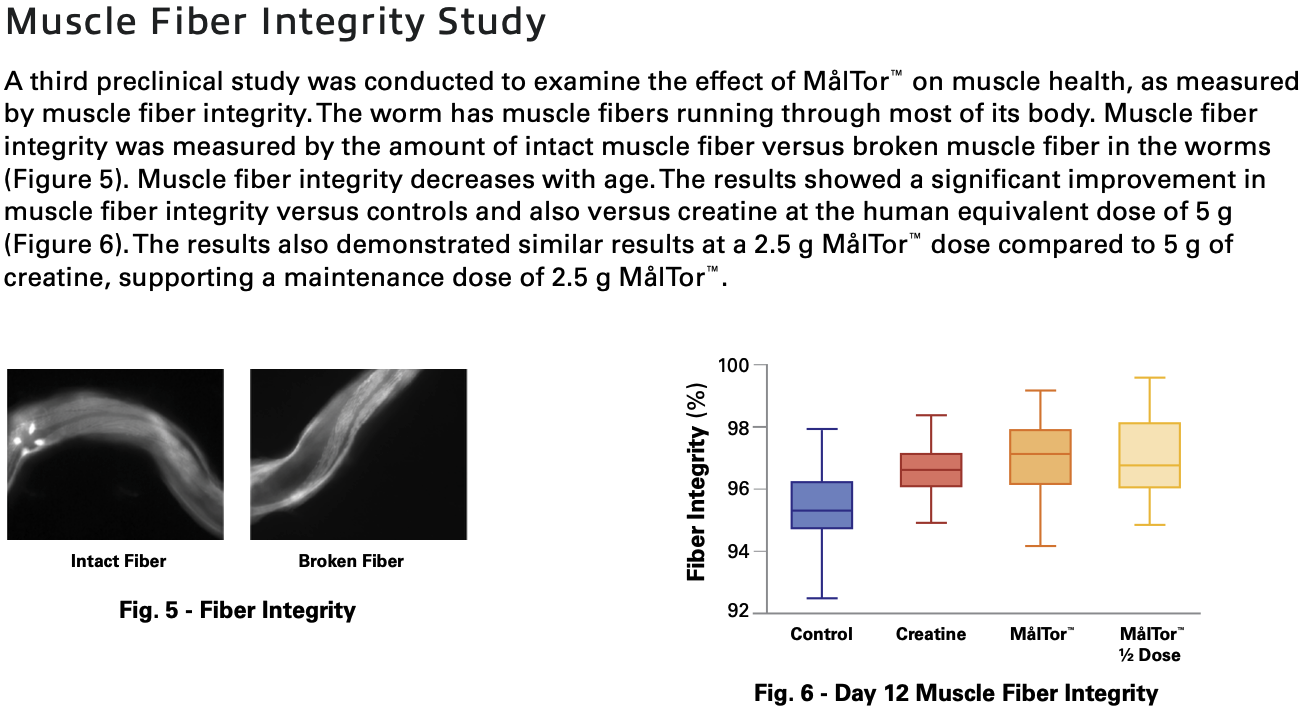
Comparative analysis of muscle fiber maintenance in C. elegans, showing MalTor™ significantly outperforms control groups and performs better than creatine in maintaining structural integrity. The left images contrast intact versus broken muscle fibers, while the box plot demonstrates that even the half-dose (2.5g) of MalTor™ provides similar protection to a full 5g dose of creatine—supporting the effectiveness of MalTor™'s maintenance dosing protocol.
But this is not all - there are likely more mechanisms of action to be uncovered, including some synergistic ones described below. But you get the point -- taurine and malic acid do an incredible amount of heavy lifting in the human body.
Now let's move back to the real world and discuss synergies with other ingredients and then their actual applications:
First, let's talk about some known synergies:
Synergistic Effects with Other Performance Enhancers
Beyond its standalone benefits, MalTor™ could combine powerful synergistic effects with other performance-enhancing compounds, potentially amplifying their effectiveness.
MalTor™ + BCAAs: The Ultimate Recovery Stack
The combination of MalTor™ with branched-chain amino acids (BCAAs) could create a potent recovery stack. Ra and colleagues conducted a groundbreaking study examining the combination of taurine and BCAAs. Their findings were remarkable:[16]
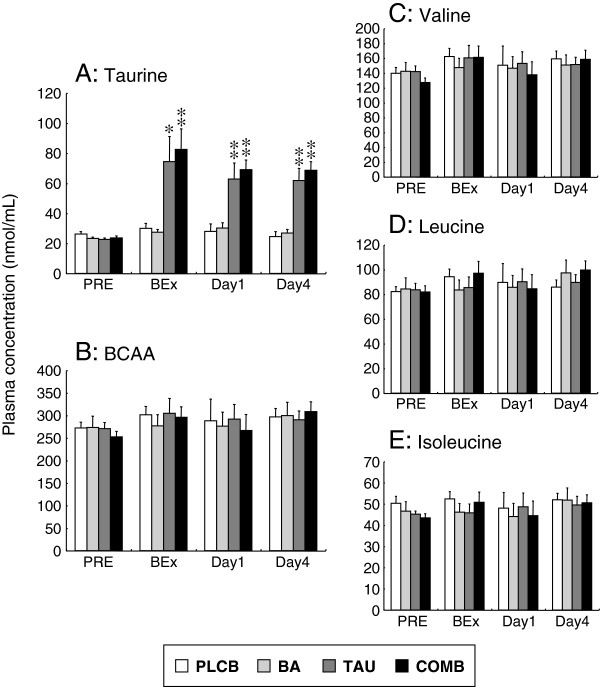
Multi-panel analysis showing plasma concentration changes of taurine and BCAAs following exercise. While BCAAs, valine, leucine and isoleucine levels (panels B-E) remain stable across all groups, panel A demonstrates significant taurine elevation in both TAU and combination groups (COMB) that persists through recovery days. This data supports the synergistic relationship between taurine and BCAAs in MalTor™'s recovery enhancement mechanisms.[16]
- The combination significantly reduced visual analog scale (VAS) scores for muscle soreness
- Markers of oxidative DNA damage (8-OHdG) were significantly lower
- Serum LDH levels remained lower from days 1-3 following eccentric exercise
- Upper arm circumference (a marker of exercise-induced swelling) was notably reduced
What makes this research useful is that it used a taurine dose (2g) lower than what's found in the MalTor™ complex, and the BCAA dose (3.2g) wasn't that large.
The researchers concluded that "a combination of 3.2 g BCAA and 2.0 g taurine, three times a day, for two weeks prior to and three days after exercise may be a useful nutritional strategy for attenuating exercise-induced DOMS and muscle damage."[16]
MalTor™ + Caffeine: Enhanced Performance Without Jitters
Another interesting synergy may exists between MalTor™ and caffeine. Research has shown that taurine can moderate some of caffeine's negative side effects while maintaining or even enhancing its performance benefits Drawing from recent research, the combination of MalTor™ and caffeine presents a great approach to performance enhancement that goes beyond individual ingredient effects.
A comprehensive study by Ozan et al. investigated the effects of caffeine, taurine, and their combination on elite male boxers. The researchers found that while both caffeine and taurine showed individual performance benefits, their co-ingestion produced the most significant improvements. Specifically, the combined supplement enhanced performance using a high dose of caffeine (6mg/kg body weight, approximately 476mg for a 175lb male) combined with 3g of taurine:[17]
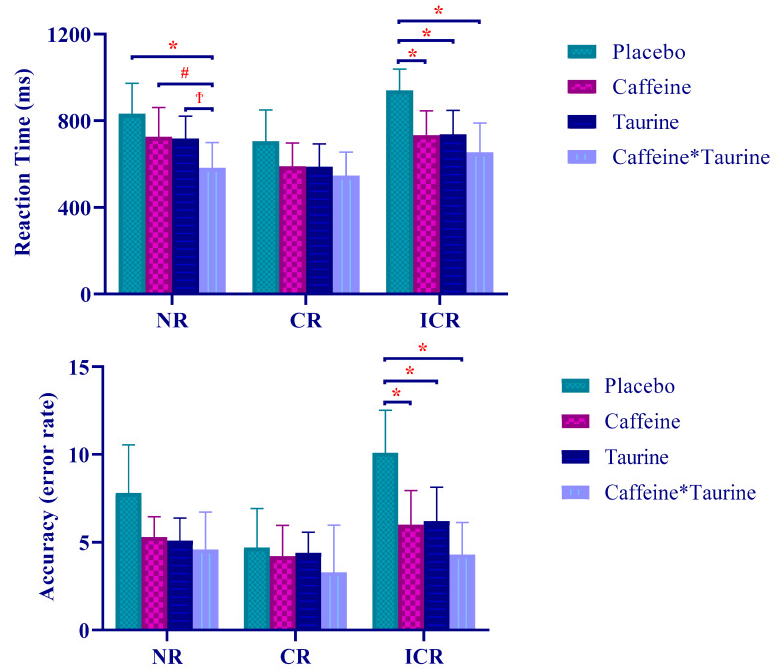
When it came to reaction time and mental accuracy, CAF*TAU absolutely crushed CAF, TAU, and the placebo.[17]
- Anaerobic power output
- Agility performance
- Balance
- Cognitive function, including reaction time and accuracy
Prior to that study, a systematic review conducted by Souza et al. further supports these findings, demonstrating that caffeine-containing energy drinks with taurine can provide meaningful performance benefits across multiple domains.[18]
The synergistic effect appears to stem from complementary mechanisms. Caffeine acts as a central nervous system stimulant, while taurine may help modulate some of caffeine's more intense effects. Additionally, taurine has been shown to support:[17]
- Calcium regulation in muscle fibers
- Neurotransmitter balance
- Reduced oxidative stress
Importantly, the study demonstrated that the combined supplement improved performance without the typical jitteriness associated with high caffeine intake. This suggests that taurine may act as a "smoothing" agent, providing a more balanced and sustained energy response.
MalTor™ + L-Citrulline: The Best of Both Worlds
The combination of MalTor™ with L-Citrulline presents a compelling approach that may offer distinct advantages over either supplement alone. While L-Citrulline has gained popularity for its ability to enhance blood flow and exercise performance, research suggests that citrulline malate may provide additional ergogenic benefits.[19]
Note that citrulline malate is technically L-citrulline bonded with malic acid, but most citrulline malate ingredients are likely blends of the two. This makes for an interesting argument for instead using citrulline + MalTor:
Complementary Pathways to Performance Enhancement

Comparison of arm circumference changes following eccentric exercise. Similar measurements between groups suggest MalTor™'s benefits come from cellular protection mechanisms rather than reduced inflammation-related swelling.[1]
L-Citrulline's primary mechanism revolves around nitric oxide (NO) production through the L-arginine-NO pathway. It effectively increases plasma arginine levels, which subsequently promotes vasodilation, improves blood flow, and enhances oxygen and nutrient delivery to working muscles.[20]By combining L-Citrulline with MalTor™, athletes can potentially experience:
- Enhanced Energy Production: While L-Citrulline focuses on improving blood flow and nutrient delivery, MalTor™'s malic acid component directly supports mitochondrial energy production through the Krebs cycle and malate-aspartate shuttle. This creates a dual-action approach addressing both delivery and utilization of energy substrates.
- Optimized Muscle Recovery: L-Citrulline has been shown to reduce muscle soreness after exercise in its own right, potentially by improving circulation and removal of metabolic waste products.[19] MalTor™ complements this through its demonstrated ability to improve pain threshold and maintain muscle fiber integrity.
- Greater Endurance Capacity: A meta-analysis by Vårvik and colleagues revealed that citrulline malate supplementation increases repetitions to failure by approximately 6.4% during resistance exercise.[20] When combining L-Citrulline with MalTor™, athletes may potentially achieve similar or enhanced benefits through complementary pathways.
The Research Advantage
Although pure L-Citrulline has a bit more popularity in pre-workout supplement formulas, the research literature actually contains more studies on citrulline malate than on L-Citrulline alone! A comprehensive review by Gough and colleagues noted that citrulline malate may provide additional benefits beyond NO production, including improved ammonia homeostasis and increased ATP production specifically through greater availability of malate.[19]
This creates a unique opportunity for formulators and athletes: By combining MalTor™ with L-Citrulline, they can effectively recreate and potentially enhance the research-backed benefits of citrulline malate while maintaining formulation flexibility. While this combination isn't quite identical to true bonded citrulline malate (which isn't commonly available in the market anyway), it provides the same core components through a potentially more effective delivery system.
The synergistic potential of MalTor™ with L-Citrulline represents an evidence-based approach to performance enhancement that addresses multiple physiological pathways simultaneously, potentially offering greater benefits than either supplement alone.
Applications in Sports Nutrition and Beyond
With such comprehensive mechanisms of action, MalTor™ has broad applications across different categories of sports nutrition formulations. Understanding these mechanisms helps explain why this novel complex delivers benefits in scenarios ranging from high-intensity interval training to endurance events and recovery support.
This leads us to the following application ideas:
Performance Enhancement Applications
MalTor™'s mechanisms suggest applications for direct performance enhancement:
-
Pre-Workout Formulations
When included in pre-workout supplements, MalTor™ can:
- Support mitochondrial function during high-intensity exercise
- Help maintain muscle integrity during challenging training sessions
- Moderate the stress response to intense exercise
- Potentially extend time to exhaustion
When combined with traditional pre-workout ingredients like caffeine, L-citrulline (both described above), and beta-alanine, MalTor™ may enhance overall efficacy while offering unique mitochondrial support not provided by these other compounds.
-
Endurance Support Products
For endurance athletes, MalTor™'s ability to enhance mitochondrial efficiency and reduce oxidative stress makes it particularly valuable in:
- Long-duration event nutrition
- Training support supplements for endurance athletes
- Electrolyte formulas designed for extended activity
Recovery-Focused Applications
Given its proven ability to reduce muscle soreness and accelerate recovery, MalTor™ is an ideal candidate for:
-
Post-Workout Recovery Products
MalTor™ can serve as a cornerstone ingredient in comprehensive post-workout formulas. Consider combining it with:
- Protein for muscle protein synthesis
- Carbohydrates for glycogen replenishment
- BCAAs for additional recovery support (with demonstrated synergy)
- Electrolytes for hydration
The recommended dosage of 5g daily for intensive training periods makes MalTor™ easy to incorporate into post-workout shakes or dedicated recovery formulas.
-
Daily Recovery Support
Even at the maintenance dose of 2.5g daily, MalTor™ provides significant mitochondrial and recovery support. This makes it suitable for:
- Daily recovery supplements
- Sleep and recovery formulas
- General wellness products targeting active individuals
Its ability to support mitochondrial health and reduce oxidative stress makes it valuable even on non-training days, potentially helping athletes maintain consistent performance throughout a training cycle.
Beyond Sports: General Health Applications
The mechanisms behind MalTor™'s effectiveness extend beyond sports performance into areas of general health and wellness, including anti-aging:
-
Mitochondrial Health Support
As research increasingly recognizes the central role of mitochondrial health in overall wellbeing and aging, MalTor™ offers a scientifically-supported approach to:
C-reactive protein changes showing MalTor™ users experienced less dramatic CRP fluctuations than placebo users. This supports MalTor's ability to regulate inflammatory responses following intense exercise, potentially contributing to faster recovery.[1]
- Support cellular energy production
- Reduce age-related oxidative stress
- Maintain metabolic flexibility
-
Metabolic Support
The research by Chen and colleagues suggests potential applications in metabolic health through the gut-liver axis, potentially supporting:[13]
- Healthy inflammatory balance
- Optimal metabolic function
- Proper nutrient utilization
Cellular, mitochondrial and metabolic health are cornerstones for increasing healthspan, the basic goal of anti-aging. Maltor is the kind of once-in-a-lifetime product which may help keep an active lifestyle for longer and increase healthspan.
Formulation Notes for Product Developers
MalTor™ offers practical advantages for formulators incorporating it into finished products. The ingredient can be dosed at either 5g daily (clinically supported) or 2.5g daily (maintenance dose) depending on the intended application. It features excellent mixability in both powder and capsule formats, with a mildly tart taste profile that's well masked in flavored systems.[2]
For optimal results, consider pairing MalTor™ with complementary ingredients like those listed above as well as electrolytes, antioxidants, or other recovery compounds to enhance its mitochondrial and anti-inflammatory mechanisms while leveraging its clean label profile and 2+ year shelf stability.
Safety and Quality Considerations
MalTor™ demonstrates an excellent safety profile in both clinical and preclinical settings. In the human clinical trial conducted by Evans et al., no tolerability issues or adverse events were reported during the two-week supplementation period, confirming its safety for daily consumption at the full 5g clinical dose. The researchers specifically noted that there were "no tolerability issues identified" throughout the study, providing confidence for regular use in healthy, active adults.[1] This safety profile stems from MalTor's foundation in two well-established nutritional compounds rather than novel synthetic molecules.
From a regulatory perspective, MalTor™ is classified as an Old Dietary Ingredient (ODI) based on its complex of taurine and L-malic acid, both of which individually hold GRAS (FDA Generally Recognized As Safe) status. NutriScience confirms that a "MalTor™ GRAS self-assessment has been completed to further validate its safety profile.
Unlike many pre-workout performance enhancers, MalTor™ is stimulant-free, making it suitable for athletes with stimulant sensitivities and those training later in the day. It's also WADA-compliant, vegan, gluten-free, non-GMO, and free from common allergens, enhancing its appeal for athletes with various dietary restrictions.
Quality assurance is paramount in NutriScience's production of MalTor™, with rigorous batch-to-batch consistency protocols ensuring reliable performance. The proprietary manufacturing process creates the specific taurine-L-malic acid complex without using excipients, additives, processing aids, or bulking agents, resulting in a clean-label ingredient. This commitment to purity, combined with the >2-year shelf stability, makes MalTor™ a reliable and trusted ingredient for formulators and supplement users alike.
Conclusion: MalTor — Recovery Backed by Mitochondria
Throughout this comprehensive article, we've seen how MalTor represents a step ahead in sports nutrition supplementation. This isn't just another recovery ingredient, it's a novel mitochondrial-enhancing tool designed to help athletes bounce back faster and support long-term performance through multiple complementary mechanisms.
The synergistic combination of taurine and L-malic acid in MalTor works at the cellular level to optimize mitochondrial function, reduce oxidative stress, accelerate muscle recovery processes, and support anti-aging. This multifaceted approach addresses the root causes of delayed onset muscle soreness and training fatigue, rather than simply masking symptoms.
What sets MalTor apart is its strong scientific foundation. With human clinical data demonstrating improved pain threshold and trends toward better strength preservation, plus extensive preclinical research showing enhanced muscle fiber integrity and mitochondrial function, MalTor delivers evidence-based benefits that athletes can count on. The fact that these benefits appear at both the full clinical dose (5g) and maintenance dose (2.5g) provides flexibility for different training phases and recovery needs.
Additionally, MalTor achieves these benefits with an exceptional safety profile: No loading phase required, no stimulant side effects, GRAS and combined "old dietary ingredient" status, and its clean-label transparency that makes it suitable for international formulation and daily use. This combination of efficacy, safety, and versatility positions MalTor as a valuable addition to post-workout formulas, daily recovery supplements, and any product aimed at supporting active lifestyles.
As the sports nutrition industry increasingly focuses on recovery as the key to consistent performance gains, MalTor stands ready to meet this need with scientifically validated, mitochondria-focused support that helps athletes train harder, recover faster, and perform better.

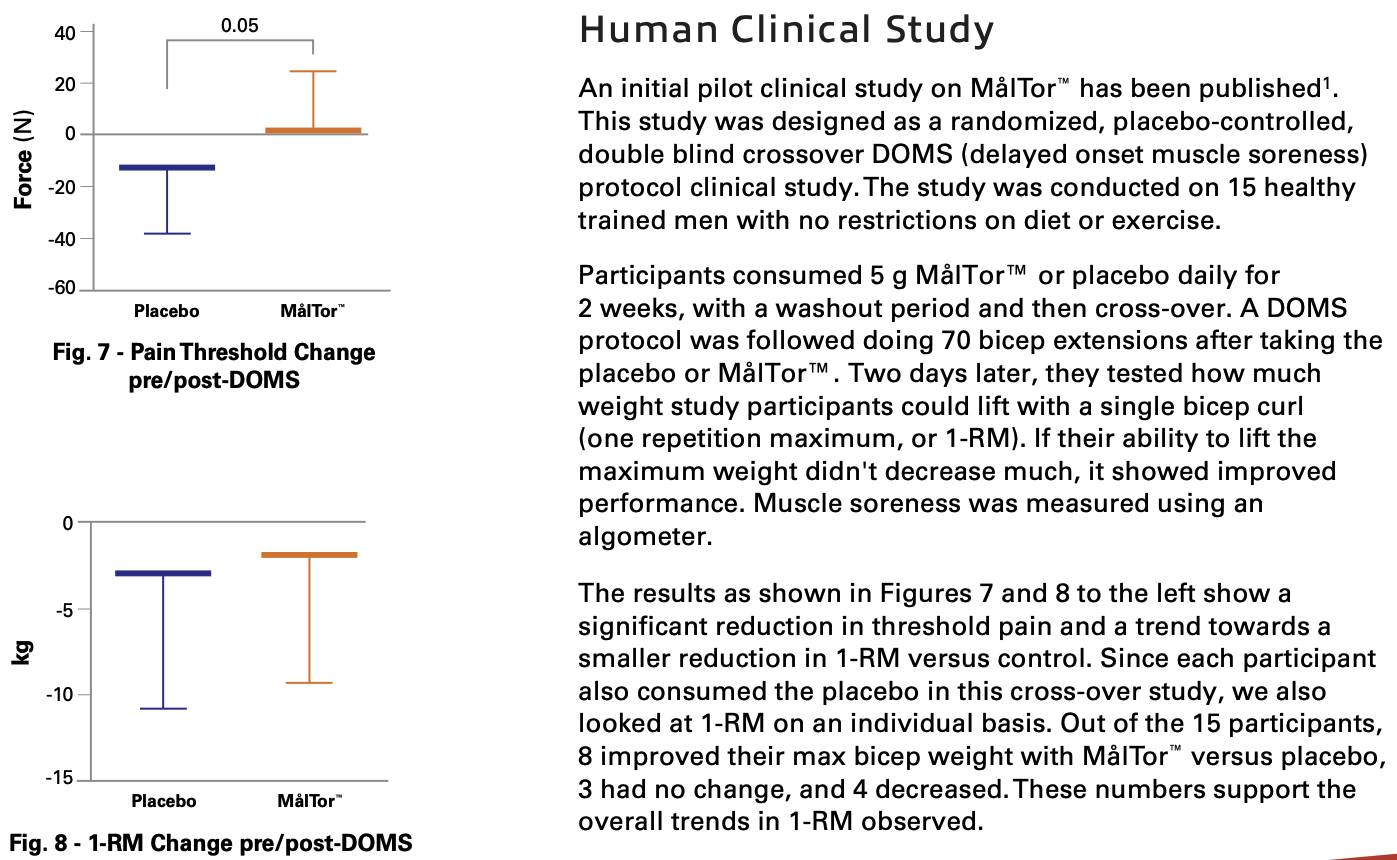
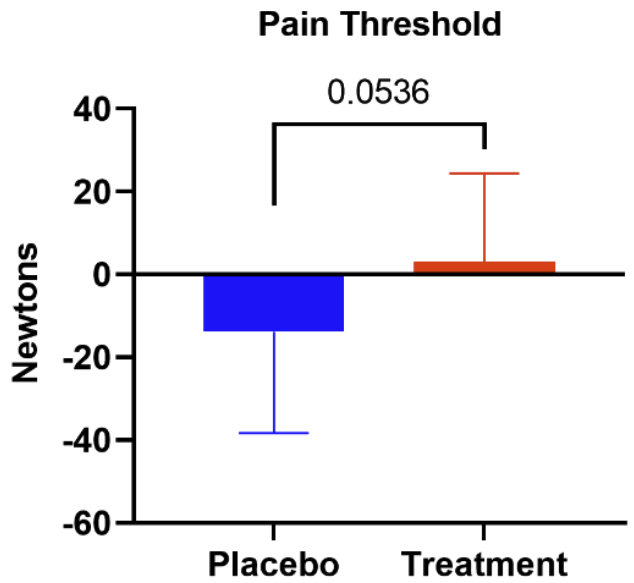

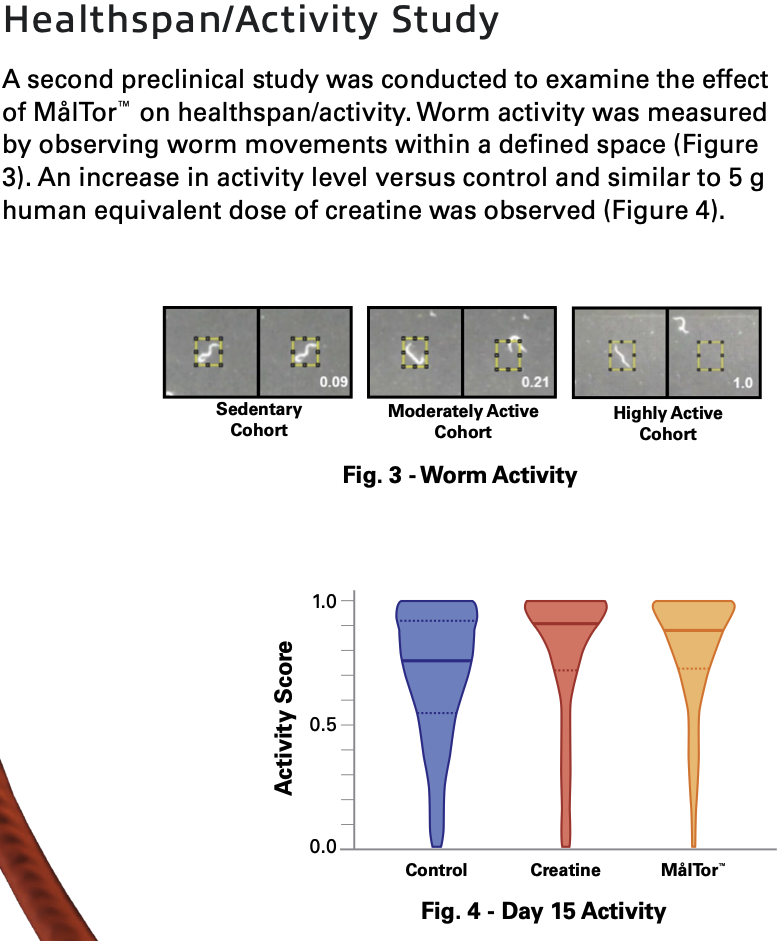
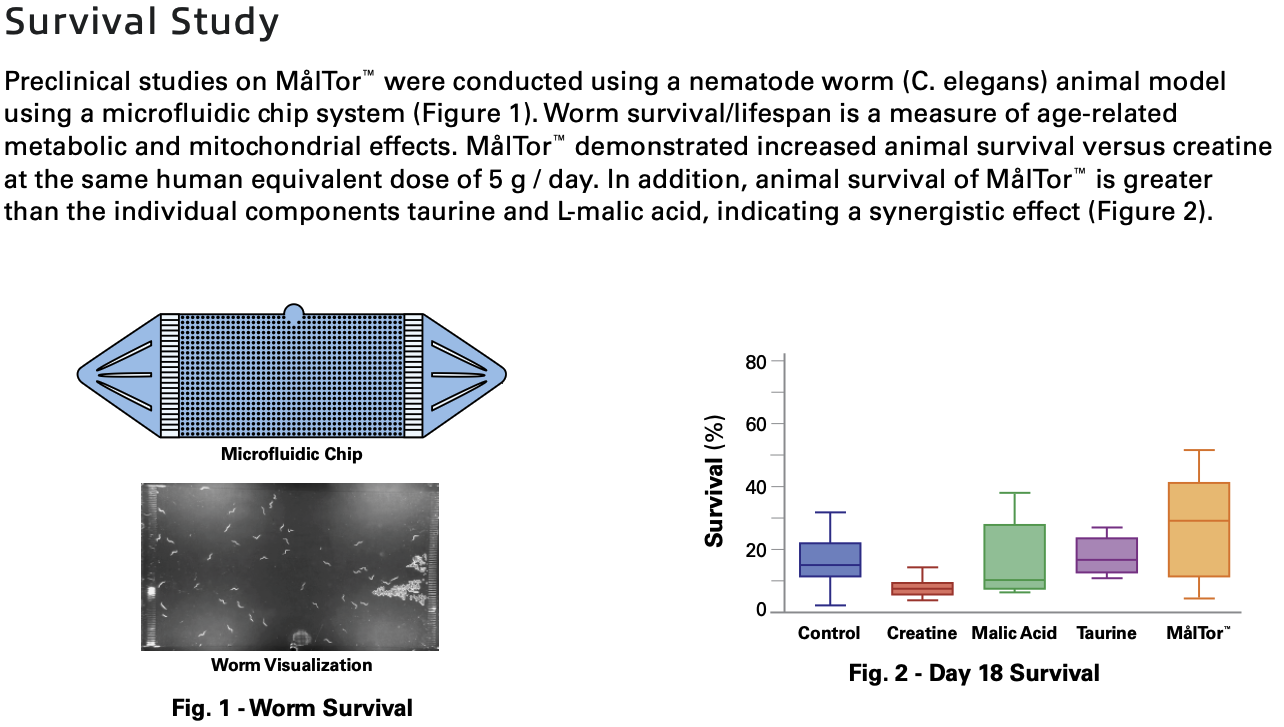
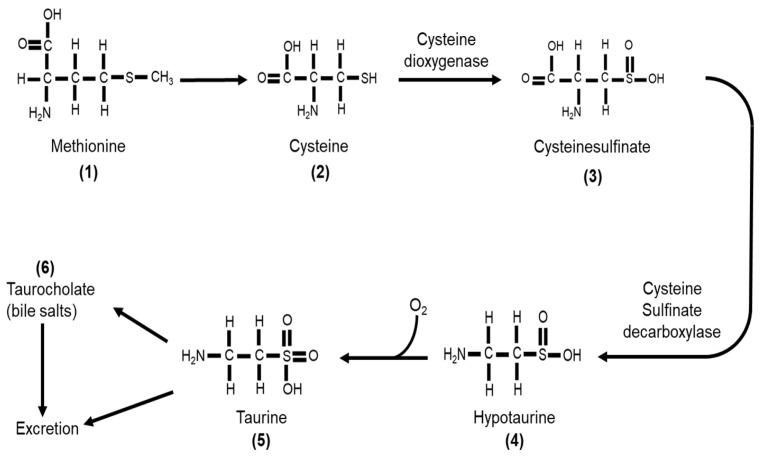
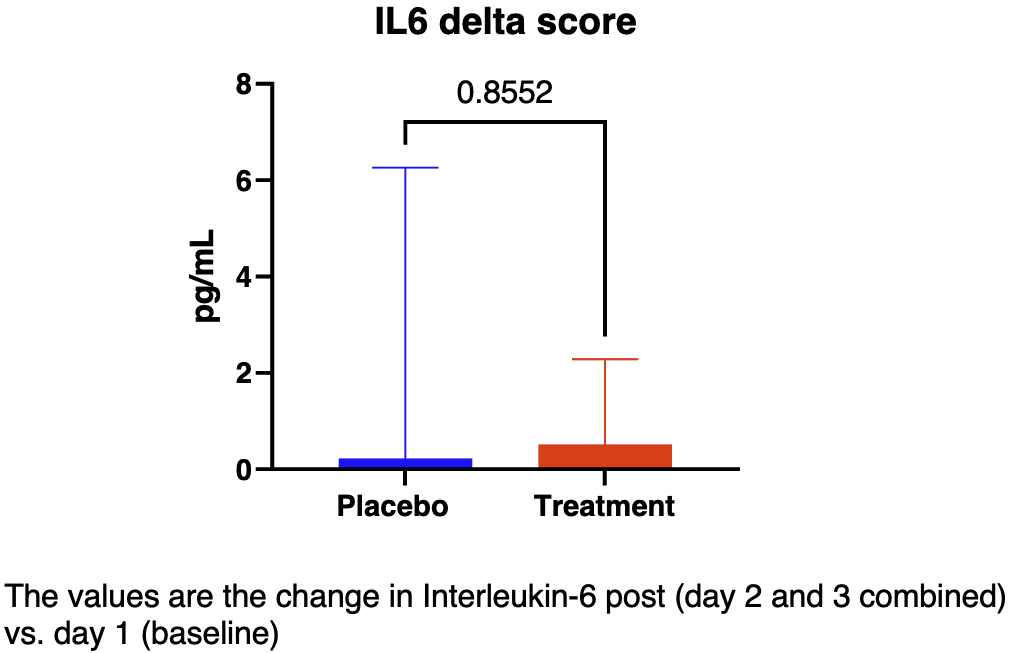
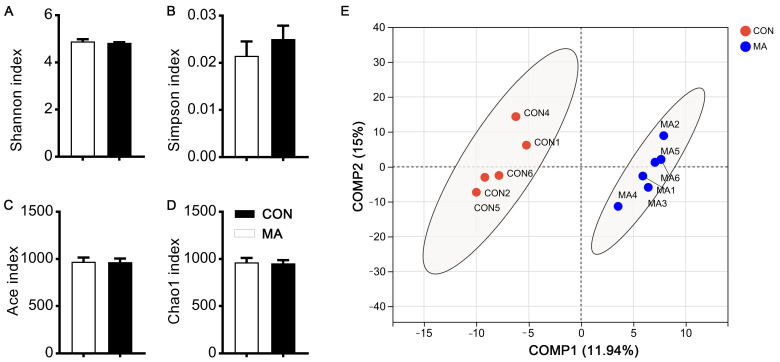
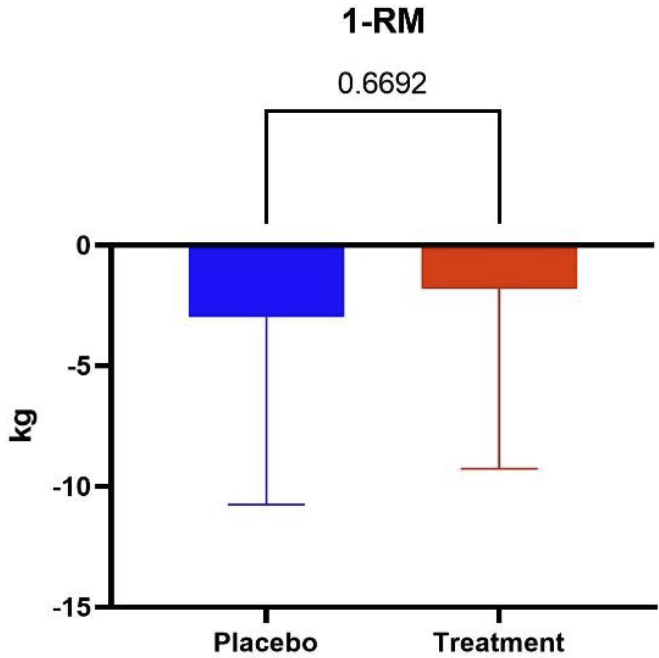
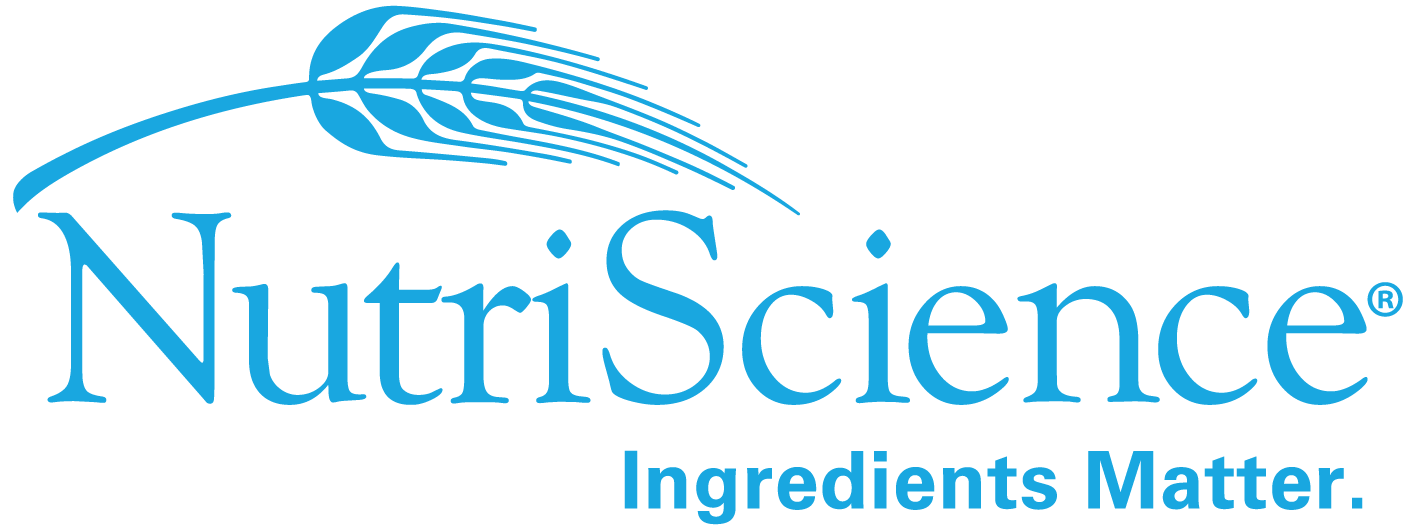
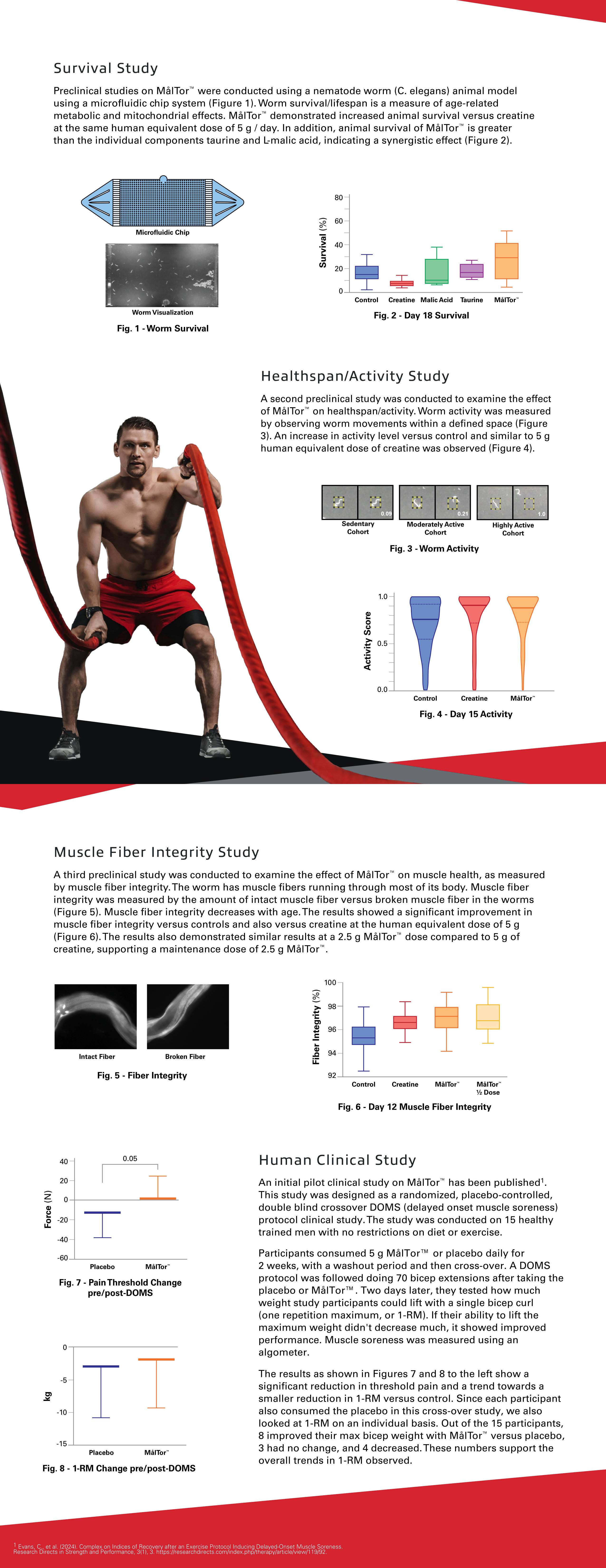
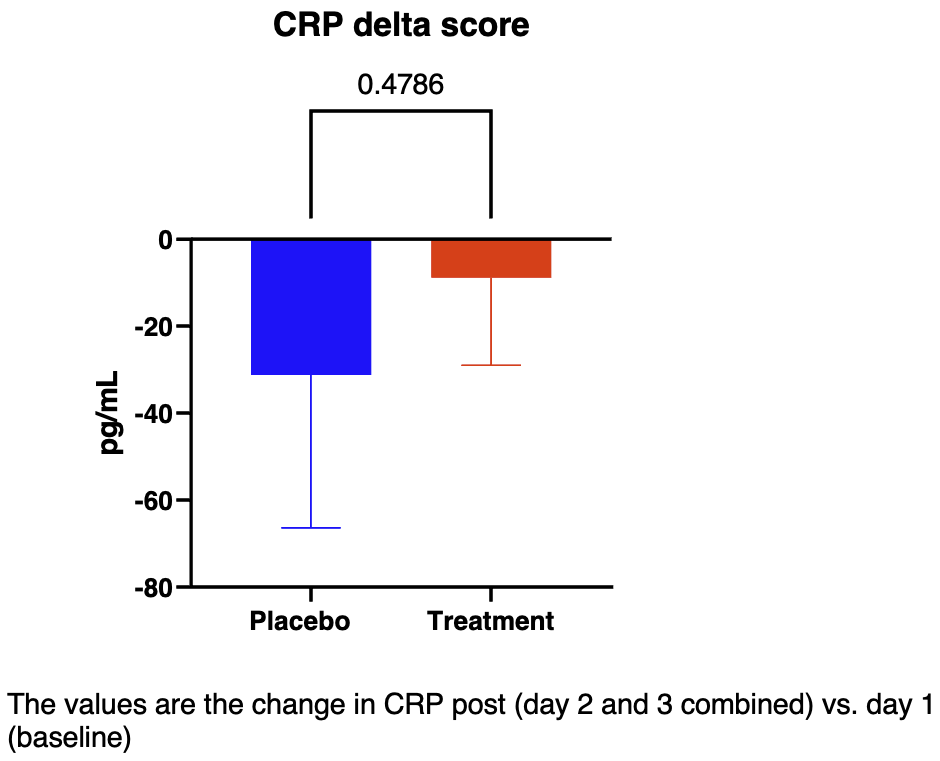

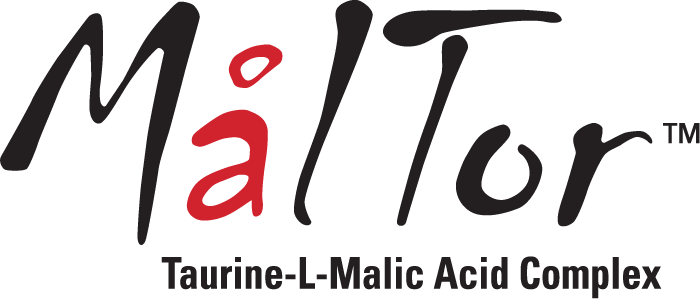


Comments and Discussion (Powered by the PricePlow Forum)